The story opens with camera moving over “our mountain” (as Billy calls Mt. Rainier). We see the snow-capped peak, birds of prey, ancient forests, birds nesting, flying insects, fish, and water–the Nisqually River, the delta, the ocean. There is a slow fade into a dream-like scene. It is night and we see a young, athletic-looking boy in a canoe on the river. A harsh police spotlight lands on the boy and we hear an angry voice: ‘Stop! You’re under arrest!’ We then hear the lyrical voice of Valerie Bridges, Billy’s young niece. She tells us, “My uncle was arrested when he was just fourteen years old. He was fishing like he always had, like we always had, for thousands of years.”
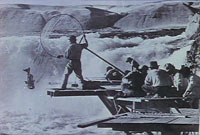 |
| Salmon fishing on Columbia River (Courtesy National Archives) |
Archival footage shows Indians standing on fish platforms as they bring in abundant catches of huge salmon. Valerie states, “For us, the salmon have always been sacred. This is hard for non-Indians to understand. In the early days, there were so many salmon, some said you could walk across the water on their spines.” Cut to Billy Frank in present day as he sits in front of the delta and tells us, “The tide goes out, and the tide comes in, twice in 24 hours, and that is very important to the world as it moves and the world as it goes around and the moon and the stars and everything that makes us, makes us whole.”
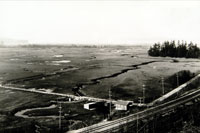 |
| Nisqually Delta, 1934 (Courtesy National Archives) |
We move back and forth through time using archival footage of salmon fishing and the “fish wars,” present-day interviews, and Valerie’s voice over. Valerie tells us about the original treaty that was the basis for the Boldt decision. “Over a hundred years ago, my ancestors came down to Nisqually to sign the Treaty of Medicine Creek. This was Washington Territory then, and the whites convinced the Indians to trade their lands in exchange for the right to fish in all the usual and accustomed places. This wasn’t the way it worked out.” This informal storytelling conveys some of the more complicated historical aspects as well as the intimate lives of the Frank and Bridges families.
As we hear Valerie’s voice, we see paintings of 1850s Washington Territory— Indians trading, white farmers, Chief Leschi, and Governor Stevens, known for bragging, “I can get these Indians to sign their own death warrants.” Valerie tells us how Stevens insisted on negotiating in an unfamiliar dialect; consequently the treaty relegated the tribes to a small area of land without river access. Because of this, Chief Leschi led a rebellion–and was wrongfully hanged by Stevens in 1858. Over a montage of family photographs, we hear how the story of Leschi was passed from one generation to the next, how Billy’s grandfather, then a small boy, was present at the awful hanging. The scene ends at the site of the 1854 treaty signing: the Treaty Tree today is a snag but still upright. Valerie hints at the irony that the Treaty of Medicine Creek became the weapon with which Northwest Indians eventually won legal affirmation of their fishing rights.
1940s and ‘50s archival footage shows the booming growth of the Seattle/Tacoma area, the voracious timber industry, and the depleted salmon and their habitat. Valerie explains that the state began to blame the Indians for the loss of the salmon harvest. Thus began the “fish wars.”
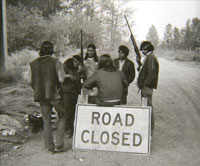 |
| The Fish Wars (Courtesy National Archives) |
Gritty, dramatic footage from the 1960s reveals that hundreds of arrests were made as Indian men, women and children attempted to bring in their salmon. Maiselle Bridges and Norma Frank are shown dragged through the mud by state game officers. Valerie tells us matter of factly that her mother and aunt went out to fish because the rest of their family was already in jail—and they were hungry.
We hear from Sue Hvalsoe Komori as she talks about being a young Vista worker brought to the encampment and greeted by Maiselle who asks, “Well, are you going to come live with us?” She describes Maiselle as the person who held the family together; she was also a center of persistence and energy, full of strategy for the protests.
Cut to Maiselle as she tells us stories from the arrests and the beginning of the fish-ins and protests. Erupting on the screen are newspaper headlines and archival footage of civil rights demonstrations and protests from Selma to Wounded Knee. Hank Adams, a pivotal strategist for the Indian protests, talks of how the various political movements of the 1960’s fed off of each other.
We see footage from the 1970s of Billy, rugged and handsome. We hear Valerie tell of Billy’s drinking, how she pleaded, “Uncle, you’ve got to stop. Uncle, you can save our world if you stop.” Cut to the Billy of today as he speaks of his drinking days. We see Maiselle working in her flower garden, remembering the day she picked up “another drunk Indian,” realized it was Billy, and convinced him to get help. Cut to Billy shaking his head, remembering how his drinking saddened Valerie. He admits she was right–you can’t save the world when you’re drunk.
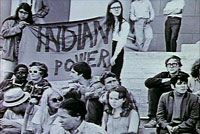 |
| Demonstration at State Capitol, 1970 (Courtesy Carol Burns) |
Washington state officials tell us that Indians are renegades and poachers who take fish away from legitimate fisherman. Sue says, “Tacoma had open season, I mean shooting Indians.” Valerie comments, “I think the fishing issue was to Washington State what busing was to the East.” We see Billy, his nieces, Hank, Sue and others staging fish-ins on State Capitol steps. Marlon Brando, Dick Gregory, and Buffy Sainte-Marie journey to Frank’s Landing to register support. Suzette Bridges screams passionately into a megaphone. Allison, the other sister, sorrowfully exclaims about both the federal and state governments, “They’d just as soon kill us as look at us.”
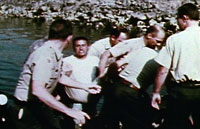 |
| Billy Frank arrested, 1970 (Courtesy Carol Burns) |
Valerie confides that it was the courage of people willing to make these protests and others like it that led to the battle in the courts. We watch a dramatic encounter when Indians are gassed on the Puyallup River in 1970 by police using guns, dogs, and clubs. At last the federal government decides to take up the Indian cause, assigning U.S. versus Washington to Judge Hugo Boldt, a conservative judge not known for sympathy to Indian causes. Through interview material from Billy, Hank, Maiselle, and Sue we come to understand the legal twists and turns of the Boldt courtroom drama. Intercut with this is news footage of the trial. Billy Frank, with his brilliant, gentle, disarming and persuasive testimony in the Boldt courtroom, changes the face of Indian history. In 1974, Judge Boldt rules not only in favor of the Indians but awards them 50% of the available salmon in any given season, something the Indians never expected. We see news footage just after the decision is announced and hear on the street interviews with outraged whites. Cut to image of Judge Boldt hanging in effigy in front of the Court House, and “Can Judge Boldt” bumper stickers. Sue tells us that as soon as the Boldt decision came down Billy stopped drinking.
But the story doesn’t end here. The State of Washington refused to comply with the law for many years. Billy walks us through the streets of present-day Tacoma, and recalls the suit brought against the cities of Tacoma and Centralia to mitigate the impact of dams upriver. We hear Judge Grossman tell of bringing the courtroom to Willy Frank, Billy’s father, who testified at the age of 104 in his home at Frank’s Landing. We see another unorthodox moment, when the judge orders all the attorneys to the Nisqually banks at 6 a.m. as migration season began: “There were more fish than anybody had seen in years. I made the lawyers help pull up the nets. There were tears in some people’s eyes.” Maiselle walks in a graveyard, carrying flowers. She allows that it was Billy who has the ability to get things done, to work smoothly and without rancor in the white man’s world—even through personal tragedy: she places flowers on the grave of Billy’s daughter and granddaughter, killed in a car accident in the 1970s.
As Billy checks activity at the fish hatchery, Valerie recalls how her uncle charmed the powers at Ft. Lewis (the fort that commandeered land from the tribe many years before) to allow the new fish hatchery on Fort property. As we see Billy playing golf with the General, he reflects that, yes he had been angry at the Fort for stealing Indian land, but that the Army is actually a good land steward. Now he has Fort keys in his pocket. Cut back to Maiselle, allowed by the Fort to gather medicinal plants on Fort land, as she laughingly observes that Billy is an actual member of the Officer’s Club! Only a renegade like Billy would be accorded such an “honor.”
U.S. Senator Daniel Inouye describes how after meeting Billy, he perhaps neglects even his own Hawaiian constituents in favor of spending time on Indian issues. Over shots of Billy with President Clinton, and footage of him talking with President Bush, Valerie says, “My uncle is a peaceful and pragmatic warrior, always looking at the big picture, never giving up. He knows we can’t get rid of I-5 cutting through the Delta, but we can clean up the rivers and save our salmon.”
Using juxtaposition between footage of Billy working on Native issues in New Mexico, Arizona, and Washington D.C., we watch Maiselle walk to Wa He Lut School, where children are learning arithmetic and Indian traditions. Valerie notes that the two paths—Billy’s ongoing political activism and natural resource management, Maiselle’s efforts to ensure Indian children learn educationally and culturally–support each other and fulfill the lessons of their elders. In the last scene we see Billy and Maiselle together on the water. Valerie says with conviction, “Even though I watch from above, I see the everlasting change that my family has brought to this world.” Fade to black. End with card: in memory of Maureen and Cabaqhud Frank, Al Bridges, and Valerie Bridges.
 The
Way to the River: Treatment
The
Way to the River: Treatment